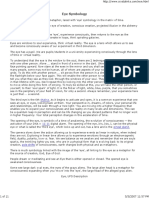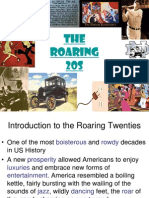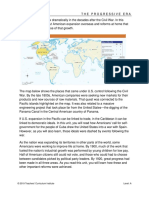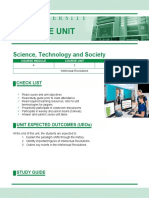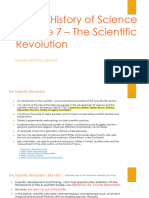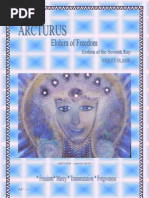CH 22 Sec 1 - The Scientific Revolution
CH 22 Sec 1 - The Scientific Revolution
Uploaded by
MrEHsiehCopyright:
Available Formats
CH 22 Sec 1 - The Scientific Revolution
CH 22 Sec 1 - The Scientific Revolution
Uploaded by
MrEHsiehOriginal Title
Copyright
Available Formats
Share this document
Did you find this document useful?
Is this content inappropriate?
Copyright:
Available Formats
CH 22 Sec 1 - The Scientific Revolution
CH 22 Sec 1 - The Scientific Revolution
Uploaded by
MrEHsiehCopyright:
Available Formats
Page 1 of 6
The Scientific Revolution
MAIN IDEA
SCIENCE AND TECHNOLOGY In the mid-1500s, scientists began to question accepted beliefs and make new theories based on experimentation.
WHY IT MATTERS NOW
Such questioning led to the development of the scientific method still in use today.
TERMS & NAMES
geocentric theory Scientific Revolution heliocentric theory Galileo Galilei scientific method Isaac Newton
SETTING THE STAGE As you recall, the period between 1300 and 1600 was
a time of great change in Europe. The Renaissance, a rebirth of learning and the arts, inspired a spirit of curiosity in many fields. Scholars began to question ideas that had been accepted for hundreds of years. Meanwhile, the religious movement known as the Reformation prompted followers to challenge accepted ways of thinking about God and salvation. While the Reformation was taking place, another revolution in European thought had begun, one that would permanently change how people viewed the physical world.
The Roots of Modern Science
Before 1500, scholars generally decided what was true or false by referring to an ancient Greek or Roman author or to the Bible. Few European scholars challenged the scientific ideas of the ancient thinkers or the church by carefully observing nature for themselves.
The Medieval View During the Middle Ages, most scholars believed that the
TAKING NOTES
Analyzing Causes Use a diagram to list the events and circumstances that led to the Scientific Revolution.
earth was an immovable object located at the center of the universe. According to that belief, the moon, the sun, and the planets all moved in perfectly circular paths around the earth. Common sense seemed to support this view. After all, the sun appeared to be moving around the earth as it rose in the morning and set in the evening. This earth-centered view of the universe was called the geocentric theory. The idea came from Aristotle, the Greek philosopher of the fourth century B.C. The Greek astronomer Ptolemy (TOLamee) expanded the theory in the second century A.D. In addition, Christianity taught that God had deliberately placed the earth at the center of the universe. Earth was thus a special place on which the great drama of life unfolded.
A New Way of Thinking Beginning in the mid-1500s, a few scholars published works that challenged the ideas of the ancient thinkers and the church. As these scholars replaced old assumptions with new theories, they launched a change in European thought that historians call the Scientific Revolution. The Scientific Revolution was a new way of thinking about the natural world. That way was based upon careful observation and a willingness to question accepted beliefs.
Causes of the Scientific Revolution
Enlightenment and Revolution 623
Page 2 of 6
A combination of discoveries and circumstances led to the Scientific Revolution and helped spread its impact. During the Renaissance, European explorers traveled to Africa, Asia, and the Americas. Such lands were inhabited by peoples and animals previously unknown in Europe. These discoveries opened Europeans to the possibility that there were new truths to be found. The invention of the printing press during this period helped spread challenging ideasboth old and new more widely among Europes thinkers. The age of European exploration also fueled a great deal of scientific research, especially in astronomy and mathematics. Navigators needed better instruments and geographic measurements, for example, to determine their location in the open sea. As scientists began to look more closely at the world around them, they made observations that did not match the ancient beliefs. They found they had reached the limit of the classical worlds knowledge. Yet, they still needed to know more.
A Revolutionary Model of the Universe
An early challenge to accepted scientific thinking came in the field of astronomy. It started when a small group of scholars began to question the geocentric theory.
The Heliocentric Theory Although backed by authority and common sense, the
Saturn
This model shows how Copernicus saw the planets revolving around the sun.
geocentric theory did not accurately explain the movements of the sun, moon, and planets. This problem troubled a Polish cleric and astronomer named Nicolaus Copernicus (kohPURnuhkuhs). In the early 1500s, Copernicus became interested in an old Greek idea that the sun stood at the center of the universe. After studying planetary movements for more than 25 years, Copernicus reasoned that indeed, the stars, the earth, and the other planets revolved around the sun. Copernicuss heliocentric, or suncentered, theory still did not completely explain why the planets orbited the way they did. He also the stars Earth Venus knew that most scholars and clergy Mars Sun Mercury Jupiter would reject his theory because it contradicted their religious views. Fearing ridicule or persecution, Copernicus did not publish his findings until 1543, the last year of his life. He received a copy of his book, On the Revolutions of the Heavenly Bodies, on his deathbed. While revolutionary, Copernicuss book caused little stir at first. Over the next century and a half, other scientists built on the foundations he had laid. A Danish astronomer, Tycho Brahe (TEEkoh brah), carefully recorded the movements of the planets for many years. Brahe produced mountains of accurate data based on his observations. However, it was left to his followers to make mathematical sense of them. After Brahes death in 1601, his assistant, a brilliant mathematician named Johannes Kepler, continued his work. After studying Brahes data, Kepler concluded that certain mathematical laws govern planetary motion. One of these laws showed that the planets revolve around the sun in elliptical orbits instead of circles, as was previously thought. Keplers laws showed that Copernicuss basic ideas were true. They demonstrated mathematically that the planets revolve around the sun.
Recognizing Effects How did Keplers findings support the heliocentric theory?
624 Chapter 22
Page 3 of 6
Galileos Discoveries An Italian scientist named Galileo Galilei built on the new theories about astronomy. As a young man, Galileo learned that a Dutch lens maker had built an instrument that could enlarge far-off objects. Galileo built his own telescope and used it to study the heavens in 1609. Then, in 1610, he published a small book called Starry Messenger, which described his astonishing observations. Galileo announced that Jupiter had four moons and that the sun had dark spots. He also noted that the earths moon had a rough, uneven surface. This shattered Aristotles theory that the moon and stars were made of a pure, perfect substance. Galileos observations, as well as his laws of motion, also clearly supported the theories of Copernicus. Conflict with the Church Galileos findings frightened both Catholic and Protes-
tant leaders because they went against church teaching and authority. If people believed the church could be wrong about this, they could question other church teachings as well. In 1616, the Catholic Church warned Galileo not to defend the ideas of Copernicus. Although Galileo remained publicly silent, he continued his studies. Then, in 1632, he published Dialogue Concerning the Two Chief World Systems. This book presented the ideas of both Copernicus and Ptolemy, but it clearly showed that Galileo supported the Copernican theory. The pope angrily summoned Galileo to Rome to stand trial before the Inquisition. Galileo stood before the court in 1633. Under the threat of torture, he knelt before the cardinals and read aloud a signed confession. In it, he agreed that the ideas of Copernicus were false.
Analyzing Primary Sources In what two ways does Galileo seek to appease the Church? PRIMARY SOURCE With sincere heart and unpretended faith I abjure, curse, and detest the aforesaid errors and heresies [of Copernicus] and also every other error . . . contrary to the Holy Church, and I swear that in the future I will never again say or assert . . . anything that might cause a similar suspicion toward me.
GALILEO GALILEI, quoted in The Discoverers
Galileo was never again a free man. He lived under house arrest and died in 1642 at his villa near Florence. However, his books and ideas still spread all over Europe. (In 1992, the Catholic Church officially acknowledged that Galileo had been right.)
Galileo stands before the papal court.
The Scientific Method
The revolution in scientific thinking that Copernicus, Kepler, and Galileo began eventually developed into a new approach to science called the scientific method. The scientific method is a logical procedure for gathering and testing ideas. It begins with a problem or question arising from an observation. Scientists next form a hypothesis, or unproved assumption. The hypothesis is then tested in an experiment or on the basis of data. In the final step, scientists analyze and interpret their data to reach a new conclusion. That conclusion either confirms or disproves the hypothesis.
Enlightenment and Revolution 625
Page 4 of 6
1566 Marie de Coste Blanche publishes The Nature of the Sun and Earth.
1609 Kepler publishes first two laws of planetary motion.
1570
1610 Galileo
publishes Starry Messenger. 1620
1520
1543 Copernicus publishes
heliocentric theory. Vesalius publishes human anatomy textbook.
1590 Janssen
invents microscope.
1620 Bacons book Novum Organum (New Instrument) encourages experimental method.
Nicolaus Copernicus began the Scientific Revolution with his heliocentric theory.
Bacon and Descartes The scientific method did not develop overnight. The work
of two important thinkers of the 1600s, Francis Bacon and Ren Descartes (dayKAHRT), helped to advance the new approach. Francis Bacon, an English statesman and writer, had a passionate interest in science. He believed that by better understanding the world, scientists would generate practical knowledge that would improve peoples lives. In his writings, Bacon attacked medieval scholars for relying too heavily on the conclusions of Aristotle and other ancient thinkers. Instead of reasoning from abstract theories, he urged scientists to experiment and then draw conclusions. This approach is called empiricism, or the experimental method. In France, Ren Descartes also took a keen interest in science. He developed analytical geometry, which linked algebra and geometry. This provided an important new tool for scientific research. Like Bacon, Descartes believed that scientists needed to reject old assumptions and teachings. As a mathematician, however, he approached gaining knowledge differently than Bacon. Rather than using experimentation, Descartes relied on mathematics and logic. He believed that everything should be doubted until proved by reason. The only thing he knew for certain was that he existedbecause, as he wrote, I think, therefore I am. From this starting point, he followed a train of strict reasoning to arrive at other basic truths. Modern scientific methods are based on the ideas of Bacon and Descartes. Scientists have shown that observation and experimentation, together with general laws that can be expressed mathematically, can lead people to a better understanding of the natural world.
Contrasting How did Descartess approach to science differ from Bacons?
Newton Explains the Law of Gravity
By the mid-1600s, the accomplishments of Copernicus, Kepler, and Galileo had shattered the old views of astronomy and physics. Later, the great English scientist Isaac Newton helped to bring together their breakthroughs under a single theory of motion.
Changing Idea: Scientific Method
Old Science
Scholars generally relied on ancient authorities, church teachings, common sense, and reasoning to explain the physical world.
New Science
In time, scholars began to use observation, experimentation, and scientific reasoning to gather knowledge and draw conclusions about the physical world.
626 Chapter 22
Page 5 of 6
1637 Descartess 1628 Harvey
reveals how human heart functions. 1620 book Discourse on Method sets forth his scientific method of reasoning from the basis of doubt.
1662 Boyle discovers mathematical
relationship between the pressure and volume of gases, known as Boyles law.
1714
Fahrenheit invents mercury thermometer. 1720
1674 Leeuwenhoek observes
bacteria through microscope. 1670
1633 Galileo faces Inquisition for support of Copernicuss theory.
1643
Torricelli invents barometer.
1666 France establishes
Academy of Sciences.
1687 Newton
publishes law of gravity.
1660 England establishes Royal Society to support scientific study.
Clarifying Why was the law of gravitation important?
Newton studied mathematics and physics at Cambridge University. By the time he was 26, Newton was certain that all physical objects were affected equally by the same forces. Newtons great discovery was that the same force ruled motion of the planets and all matter on earth and in space. The key idea that linked motion in the heavens with motion on the earth was the law of universal gravitation. According to this law, every object in the universe attracts every other object. The degree of attraction depends on the mass of the objects and the distance between them. In 1687, Newton published his ideas in a work called The Mathematical Principles of Natural Philosophy. It was one of the most important scientific books ever written. The universe he described was like a giant clock. Its parts all worked together perfectly in ways that could be expressed mathematically. Newton believed that God was the creator of this orderly universe, the clockmaker who had set everything in motion.
Isaac Newtons law of gravity explained how the same physical laws governed motion both on earth and in the heavens.
The Scientific Revolution Spreads
As astronomers explored the secrets of the universe, other scientists began to study the secrets of nature on earth. Careful observation and the use of the scientific method eventually became important in many different fields.
Scientific Instruments Scientists developed new tools and instruments to make
the precise observations that the scientific method demanded. The first microscope was invented by a Dutch maker of eyeglasses, Zacharias Janssen (YAHNsuhn), in 1590. In the 1670s, a Dutch drapery merchant and amateur scientist named Anton van Leeuwenhoek (LAYvuhnHUK) used a microscope to observe bacteria swimming in tooth scrapings. He also examined red blood cells for the first time. In 1643, one of Galileos students, Evangelista Torricelli (TAWRuhCHEHLee), developed the first mercury barometer, a tool for measuring atmospheric pressure and predicting weather. In 1714, the German physicist Gabriel Fahrenheit (FARuhnHYT) made the first thermometer to use mercury in glass. Fahrenheits thermometer showed water freezing at 32. A Swedish astronomer, Anders Celsius (SEHLseeuhs), created another scale for the mercury thermometer in 1742. Celsiuss scale showed freezing at 0.
Medicine and the Human Body During the Middle Ages, European doctors had accepted as fact the writings of an ancient Greek physician named Galen. However, Galen had never dissected the body of a human being. Instead, he had studied the anatomy of pigs and other animals. Galen assumed that human anatomy was much the same. A Flemish physician named Andreas Vesalius proved Galens assumptions wrong. Vesalius dissected human corpses and published his observations. His Enlightenment and Revolution 627
Page 6 of 6
book, On the Structure of the Human Body (1543), was filled with detailed drawings of human organs, bones, and muscle. In the late 1700s, British physician Edward Jenner introduced a vaccine to prevent smallpox. Inoculation using live smallpox germs had been practiced in Asia for centuries. While beneficial, this technique could also be dangerous. Jenner discovered that inoculation with germs from a cattle disease called cowpox gave permanent protection from smallpox for humans. Because cowpox was a much milder disease, the risks for this form of inoculation were much lower. Jenner used cowpox to produce the worlds first vaccination.
Discoveries in Chemistry Robert Boyle pioneered the use of the scientific method in chemistry. He is considered the founder of modern chemistry. In a book called The Sceptical Chymist (1661), Boyle challenged Aristotles idea that the physical world consisted of four elementsearth, air, fire, and water. Instead, Boyle proposed that matter was made up of smaller primary particles that joined together in different ways. Boyles most famous contribution to chemistry is Boyles law. This law explains how the volume, temperature, and pressure of gas affect each other. The notions of reason and order, which spurred so many breakthroughs in science, soon moved into other fields of life. Philosophers and scholars across Europe began to rethink long-held beliefs about the human condition, most notably the rights and liberties of ordinary citizens. These thinkers helped to usher in a movement that challenged the age-old relationship between a government and its people, and eventually changed forever the political landscape in numerous societies.
Vocabulary
Inoculation is the act of injecting a germ into a persons body so as to create an immunity to the disease.
The famous Dutch painter Rembrandt painted Anatomy Lesson of Dr. Tulp in 1632 from an actual anatomy lesson. The corpse was that of a criminal.
SECTION
ASSESSMENT
TERMS & NAMES 1. For each term or name, write a sentence explaining its significance.
geocentric theory Scientific Revolution heliocentric theory Galileo Galilei scientific method Isaac Newton
USING YOUR NOTES
2. Which event or circumstance
MAIN IDEAS
3. Before the 1500s, who and
CRITICAL THINKING & WRITING
6. DRAWING CONCLUSIONS If I have seen farther than
do you consider to be the most significant? Why?
what were the final authorities with regard to most knowledge?
4. How did the heliocentric theory
others, said Newton, it is because I have stood on the shoulders of giants. Could this be said of most scientific accomplishments? Explain.
7. ANALYZING MOTIVES Why might institutions of authority
of the universe differ from the geocentric theory?
Causes of the Scientific Revolution
tend to reject new ideas?
8. FORMING AND SUPPORTING OPINIONS Do you agree
5. What are the main steps of the
scientific method?
with Galileos actions during his Inquisition? Explain.
9. WRITING ACTIVITY SCIENCE AND TECHNOLOGY Create a
television script for a discovery of the Scientific Revolution. Include key people, ideas, and accomplishments.
CONNECT TO TODAY CREATING A GRAPHIC
Research a modern-day invention or new way of thinking and then describe it and its impact on society to the class in a poster or annotated diagram.
628 Chapter 22
You might also like
- CH 27 Sec 4 - British Imperialism in IndiaDocument5 pagesCH 27 Sec 4 - British Imperialism in IndiaMrEHsieh100% (2)
- CH 22 Sec 3 - The Enlightenment SpreadsDocument4 pagesCH 22 Sec 3 - The Enlightenment SpreadsMrEHsieh100% (2)
- Early AmericaDocument157 pagesEarly AmericaBiljanaLNo ratings yet
- Learn To Read KundaliDocument12 pagesLearn To Read Kundalianand kejriwal75% (4)
- Eye Symbology, CrystalinksDocument11 pagesEye Symbology, CrystalinksJude21No ratings yet
- CH 36 Sec 1 - The Impact of Science and Technology PDFDocument4 pagesCH 36 Sec 1 - The Impact of Science and Technology PDFMrEHsiehNo ratings yet
- CH 35 Sec 4 - Changes in Central and Eastern Europe PDFDocument7 pagesCH 35 Sec 4 - Changes in Central and Eastern Europe PDFMrEHsiehNo ratings yet
- CH 23 Sec 5 - The Congress of ViennaDocument4 pagesCH 23 Sec 5 - The Congress of ViennaMrEHsieh100% (2)
- CH 23 Sec 4 - Napoleon's Empire CollapsesDocument4 pagesCH 23 Sec 4 - Napoleon's Empire CollapsesMrEHsieh100% (1)
- CH 34 Sec 1 - The Indian Subcontinent Achieves Freedom PDFDocument7 pagesCH 34 Sec 1 - The Indian Subcontinent Achieves Freedom PDFMrEHsiehNo ratings yet
- CH 23 Sec 2 - The Revolution Brings Reform and TerrorDocument6 pagesCH 23 Sec 2 - The Revolution Brings Reform and TerrorMrEHsieh100% (1)
- CH 32 Sec 5 - Europe and Japan in RuinsDocument4 pagesCH 32 Sec 5 - Europe and Japan in RuinsMrEHsiehNo ratings yet
- CH 34 Sec 2 - Southeast Asian Nations Gain Independence PDFDocument6 pagesCH 34 Sec 2 - Southeast Asian Nations Gain Independence PDFMrEHsieh0% (1)
- CH 35 Sec 5 - China Reform and Reaction PDFDocument5 pagesCH 35 Sec 5 - China Reform and Reaction PDFMrEHsieh100% (3)
- CH 34 Sec 3 - New Nations in Africa PDFDocument5 pagesCH 34 Sec 3 - New Nations in Africa PDFMrEHsiehNo ratings yet
- CH 32 Sec 4 - The Allied Victory PDFDocument8 pagesCH 32 Sec 4 - The Allied Victory PDFMrEHsiehNo ratings yet
- CH 33 Sec 5 - The Cold War Thaws PDFDocument4 pagesCH 33 Sec 5 - The Cold War Thaws PDFMrEHsiehNo ratings yet
- Answer Key For Unit 3 Progressive Era Packet 2014Document38 pagesAnswer Key For Unit 3 Progressive Era Packet 2014Eduardo Borja100% (1)
- CH 33 Sec 4 - The Cold War Divides The World PDFDocument6 pagesCH 33 Sec 4 - The Cold War Divides The World PDFMrEHsiehNo ratings yet
- CH 24 Sec 2 - Europe Faces RevolutionsDocument5 pagesCH 24 Sec 2 - Europe Faces RevolutionsMrEHsiehNo ratings yet
- CH 31 Sec 3 - Fascism Rises in Europe PDFDocument5 pagesCH 31 Sec 3 - Fascism Rises in Europe PDFMrEHsieh100% (2)
- CH 36 AssessmentDocument2 pagesCH 36 AssessmentMrEHsiehNo ratings yet
- CH 22 Sec 2 - The Enlightenment in EuropeDocument6 pagesCH 22 Sec 2 - The Enlightenment in EuropeMrEHsiehNo ratings yet
- CH 31 Sec 1 - Postwar Uncertainty PDFDocument5 pagesCH 31 Sec 1 - Postwar Uncertainty PDFMrEHsiehNo ratings yet
- CH 29 Sec 3 - A Global Conflict PDFDocument6 pagesCH 29 Sec 3 - A Global Conflict PDFMrEHsieh100% (2)
- CH 25 Sec 3 - Industrialization SpreadsDocument5 pagesCH 25 Sec 3 - Industrialization SpreadsMrEHsiehNo ratings yet
- CH 21 Sec 1 - Spain's Empire and European AbsolutismDocument7 pagesCH 21 Sec 1 - Spain's Empire and European AbsolutismMrEHsiehNo ratings yet
- CH 20 Sec 2 - European Nations Settle North AmericaDocument5 pagesCH 20 Sec 2 - European Nations Settle North AmericaMrEHsiehNo ratings yet
- Mercantlism Triangular TradeDocument2 pagesMercantlism Triangular Tradeapi-265371560No ratings yet
- Chapter 26 The Great Depression PowerpointDocument39 pagesChapter 26 The Great Depression Powerpointapi-178733215No ratings yet
- CH 14 Sec 3 - England and France DevelopDocument5 pagesCH 14 Sec 3 - England and France DevelopMrEHsiehNo ratings yet
- CH 30 Sec 3 - Imperial China Collapses PDFDocument5 pagesCH 30 Sec 3 - Imperial China Collapses PDFMrEHsiehNo ratings yet
- Twenties Jigsaw Activity - UpdatedDocument23 pagesTwenties Jigsaw Activity - UpdatedJoana MerhebNo ratings yet
- The Americans 3.2 - PG 120 - 129Document9 pagesThe Americans 3.2 - PG 120 - 129Joe BradleyNo ratings yet
- Sciensctist ChartDocument4 pagesSciensctist ChartWillSmithNo ratings yet
- CH 19 Sec 2 - China Limits European ContactsDocument6 pagesCH 19 Sec 2 - China Limits European ContactsMrEHsiehNo ratings yet
- The Americans - Part 2 PDFDocument144 pagesThe Americans - Part 2 PDFMustafa Husain100% (1)
- The Progressive Era SummaryDocument9 pagesThe Progressive Era Summaryapi-207128377No ratings yet
- Lesson 27 The Progressive EraDocument37 pagesLesson 27 The Progressive Erafishertr1No ratings yet
- Chapter 5 - Shaping A New NationDocument23 pagesChapter 5 - Shaping A New Nationapi-233545455No ratings yet
- The Scientific RevolutionDocument3 pagesThe Scientific Revolutionapi-508882599No ratings yet
- Chapter 11 ProgressivismDocument7 pagesChapter 11 ProgressivismAshley GettingNo ratings yet
- CH 25 Sec 4 - Reforming The Industrial WorldDocument7 pagesCH 25 Sec 4 - Reforming The Industrial WorldMrEHsieh100% (1)
- U S History Timeline Cheat SheetDocument6 pagesU S History Timeline Cheat Sheetapi-262327064100% (1)
- CH 32 Sec 1 - Hitler's Lightning War PDFDocument6 pagesCH 32 Sec 1 - Hitler's Lightning War PDFMrEHsieh100% (2)
- Unit 4: A Nation Divided: Lesson 7: ReconstructionDocument22 pagesUnit 4: A Nation Divided: Lesson 7: Reconstructionmjohnsonhistory100% (1)
- Democracy in AustraliaDocument3 pagesDemocracy in Australiaapi-369751270No ratings yet
- CH 36 Sec 1-4 - Global Interdependence PDFDocument26 pagesCH 36 Sec 1-4 - Global Interdependence PDFMrEHsiehNo ratings yet
- 8th Grade U S History Ngsss-Ss Pacing Guide Year at A GlanceDocument1 page8th Grade U S History Ngsss-Ss Pacing Guide Year at A Glanceapi-366325761No ratings yet
- The EnlightenmentDocument37 pagesThe EnlightenmentJessy Bel100% (1)
- The Scientific RevolutionDocument6 pagesThe Scientific RevolutionasiimchughtaiNo ratings yet
- STSDocument4 pagesSTSFrecy Mae BaraoNo ratings yet
- AP European History Chapter 18 NotesDocument12 pagesAP European History Chapter 18 NoteslevisaadaNo ratings yet
- Course Unit-Intellectual RevolutionDocument11 pagesCourse Unit-Intellectual RevolutionRachelle Mae SalvadorNo ratings yet
- The Scientific Revolution: The Roots of Modern ScienceDocument4 pagesThe Scientific Revolution: The Roots of Modern Sciencesharyortiz08No ratings yet
- The Scientific Revolution (Assignment - Alina Becali)Document6 pagesThe Scientific Revolution (Assignment - Alina Becali)Ioan NaturaNo ratings yet
- Lecture 7 The Scientific RevolutionDocument71 pagesLecture 7 The Scientific Revolutionkaijun.cheahNo ratings yet
- The Scientific Revolution: The Roots of Modern ScienceDocument6 pagesThe Scientific Revolution: The Roots of Modern ScienceSreya MitraNo ratings yet
- The Scientific RevolutionDocument26 pagesThe Scientific RevolutioncarlosNo ratings yet
- Scientific RevolutionDocument22 pagesScientific Revolutiontheodore baiNo ratings yet
- Name Class DateDocument2 pagesName Class Dateapi-245498585No ratings yet
- Chapter 1.3Document5 pagesChapter 1.3Wild RiftNo ratings yet
- Survey of World HistoryDocument77 pagesSurvey of World Historyrufinus ondieki100% (1)
- ch13 2 PDFDocument6 pagesch13 2 PDFMohmad YousufNo ratings yet
- M5C11EADDocument4 pagesM5C11EADDaniela ScobarNo ratings yet
- CH 14 Sec 2 - Changes in Medieval SocietyDocument6 pagesCH 14 Sec 2 - Changes in Medieval SocietyMrEHsiehNo ratings yet
- CH 12 Sec 4 - Feudal Powers in JapanDocument5 pagesCH 12 Sec 4 - Feudal Powers in JapanMrEHsiehNo ratings yet
- CH 24 Sec 4 - Revolution in The Arts PDFDocument4 pagesCH 24 Sec 4 - Revolution in The Arts PDFJ. NievesNo ratings yet
- CH 27 Sec 3Document5 pagesCH 27 Sec 3api-263257778No ratings yet
- The Scramble For AfricaDocument6 pagesThe Scramble For Africajakila100% (2)
- CH 35 Sec 5 - China Reform and Reaction PDFDocument5 pagesCH 35 Sec 5 - China Reform and Reaction PDFMrEHsieh100% (3)
- CH 34 Sec 2 - Southeast Asian Nations Gain Independence PDFDocument6 pagesCH 34 Sec 2 - Southeast Asian Nations Gain Independence PDFMrEHsieh0% (1)
- CH 34 Sec 3 - New Nations in Africa PDFDocument5 pagesCH 34 Sec 3 - New Nations in Africa PDFMrEHsiehNo ratings yet
- CH 36 Sec 1-4 - Global Interdependence PDFDocument26 pagesCH 36 Sec 1-4 - Global Interdependence PDFMrEHsiehNo ratings yet
- CH 30 Sec 3 - Imperial China Collapses PDFDocument5 pagesCH 30 Sec 3 - Imperial China Collapses PDFMrEHsiehNo ratings yet
- CH 32 Sec 4 - The Allied Victory PDFDocument8 pagesCH 32 Sec 4 - The Allied Victory PDFMrEHsiehNo ratings yet
- CH 32 Sec 1 - Hitler's Lightning War PDFDocument6 pagesCH 32 Sec 1 - Hitler's Lightning War PDFMrEHsieh100% (2)
- CH 31 Sec 4 - Aggressors Invade Nations PDFDocument5 pagesCH 31 Sec 4 - Aggressors Invade Nations PDFMrEHsiehNo ratings yet
- CH 33 Sec 4 - The Cold War Divides The World PDFDocument6 pagesCH 33 Sec 4 - The Cold War Divides The World PDFMrEHsiehNo ratings yet
- CH 32 Sec 2 - Japan's Pacific Campaign PDFDocument5 pagesCH 32 Sec 2 - Japan's Pacific Campaign PDFMrEHsieh100% (2)
- CH 32 Sec 3Document4 pagesCH 32 Sec 3api-263257778100% (1)
- CH 33 Sec 5 - The Cold War Thaws PDFDocument4 pagesCH 33 Sec 5 - The Cold War Thaws PDFMrEHsiehNo ratings yet
- CH 29 Sec 1 - Marching Towards War PDFDocument4 pagesCH 29 Sec 1 - Marching Towards War PDFMrEHsieh100% (2)
- CH 29 Sec 3 - A Global Conflict PDFDocument6 pagesCH 29 Sec 3 - A Global Conflict PDFMrEHsieh100% (2)
- CH 36 AssessmentDocument2 pagesCH 36 AssessmentMrEHsiehNo ratings yet
- CH 31 Sec 3 - Fascism Rises in Europe PDFDocument5 pagesCH 31 Sec 3 - Fascism Rises in Europe PDFMrEHsieh100% (2)
- CH 31 Sec 1 - Postwar Uncertainty PDFDocument5 pagesCH 31 Sec 1 - Postwar Uncertainty PDFMrEHsiehNo ratings yet
- CH 28 Sec 2 - Modernization in JapanDocument4 pagesCH 28 Sec 2 - Modernization in JapanMrEHsieh100% (1)
- CH 32 Sec 5 - Europe and Japan in RuinsDocument4 pagesCH 32 Sec 5 - Europe and Japan in RuinsMrEHsiehNo ratings yet
- Georg Wilhelm Friedrich HegelDocument41 pagesGeorg Wilhelm Friedrich HegelAnders SamuelssonNo ratings yet
- QFT BoccioDocument63 pagesQFT Bocciounima3610No ratings yet
- ARCTURUS .Artwork by ElDocument18 pagesARCTURUS .Artwork by Elheartofthelotus100% (4)
- Secrets of Ashtakavarga Revealed - E K Dhilip KumarDocument4 pagesSecrets of Ashtakavarga Revealed - E K Dhilip KumarDilip KiningeNo ratings yet
- The Electric UniverseDocument10 pagesThe Electric UniverseAnthony E. Larson100% (1)
- Star of Bethlehem PresentationDocument50 pagesStar of Bethlehem PresentationJoshuaNo ratings yet
- Adamapollo-Info Sacred Knowledge Unified Harmonic Matrix MamcpyzmDocument13 pagesAdamapollo-Info Sacred Knowledge Unified Harmonic Matrix Mamcpyzmdr_xNo ratings yet
- Stephen Hawking PuzzlesDocument9 pagesStephen Hawking PuzzlesthaumkidNo ratings yet
- Property Dualism Vs SubstantialDocument21 pagesProperty Dualism Vs SubstantialsummerjenaraNo ratings yet
- The Yogas of Enlightenment: A Vedic Astrological Analysis of The Chart of OshoDocument6 pagesThe Yogas of Enlightenment: A Vedic Astrological Analysis of The Chart of OshoLamaCNo ratings yet
- Kepler 1649cDocument4 pagesKepler 1649csteffany3442No ratings yet
- OcculationDocument17 pagesOcculationAshish MishraNo ratings yet
- Galileo GalileiDocument6 pagesGalileo GalileiMark Cristian SaysonNo ratings yet
- Mcgrath Schelling Freudian PDFDocument20 pagesMcgrath Schelling Freudian PDFMichalJanNo ratings yet
- DeontologyDocument7 pagesDeontologywilfred chipanguraNo ratings yet
- R5 SpaceDocument3 pagesR5 SpaceJyoti Arvind PathakNo ratings yet
- Rotation and RevolutionDocument4 pagesRotation and RevolutionAmman AliNo ratings yet
- Rene DescartesDocument10 pagesRene DescarteskhafdinNo ratings yet
- Origins ThreeDocument5 pagesOrigins ThreeScott ParkerNo ratings yet
- Notes On Jaimini Astrology 1Document4 pagesNotes On Jaimini Astrology 1Vasantha Kumar NNo ratings yet
- X-Rays From The Nearby Compact Emission Line Galaxy NGC 2366Document5 pagesX-Rays From The Nearby Compact Emission Line Galaxy NGC 2366Educated ArcNo ratings yet
- Lesson 3 - Nebular TheoryDocument36 pagesLesson 3 - Nebular TheorynaikasNo ratings yet
- 3) M1 Dynamics of A Particle Moving in A Straight LineDocument84 pages3) M1 Dynamics of A Particle Moving in A Straight Linedmal88No ratings yet
- 12 Planets (Grahas) - Vedanga JyotishaDocument7 pages12 Planets (Grahas) - Vedanga JyotishaprabhaNo ratings yet
- Principle of Sufficient ReasonDocument5 pagesPrinciple of Sufficient ReasonReza Khaje0% (1)
- Q2 SCIENCE 8 Comets Asteroids MeteoroidsDocument33 pagesQ2 SCIENCE 8 Comets Asteroids MeteoroidsFabienne Anya LañojanNo ratings yet




